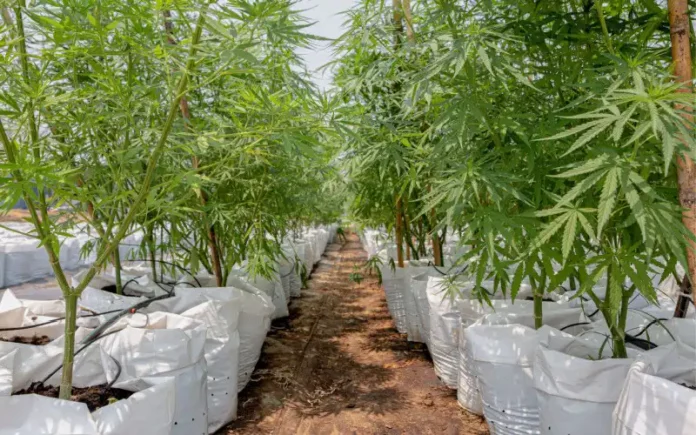VANDALIA, Missouri — Missouri growers cannabis cultivation usually elicits images of LED lighting closely illuminating crowded rows of seven-leafed plants. But drive 100 miles northwest of St. Louis and you’ll be standing among two acres of marijuana plants that reach 8 feet tall and have branches buckling under the weight of hefty buds.
Ohio-based Standard Wellness is a multi-state operator and one of Missouri’s four current licensed cultivators that grow their products outside. But why outside?
“Why do we grow cannabis indoors?” Joshua Cason, cultivation manager at Standard Wellness in Missouri, countered. “It used to be that the worst thing you could do was tell people [you’re growing cannabis]. Now it’s legal. We don’t have to be nervous.”
Legal sales of recreational adult-use marijuana were approved by Missouri voters in November, and began in February. Sales through September have reached nearly $738 million, according to the state Department of Health and Senior Services. Standard Wellness’ Missouri branch generates about $13 million annually, with plans to increase production next year.
Most of its product is grown indoors, but Cason said the company sees a future for open-air operations and is trying to establish cannabis as an outdoor cash crop in Missouri, where soybeans, corn and hay generate billions of dollars annually.
“The agriculture here is amazing,” Cason said. “We’re jumping in. We want to fit cannabis in that and make Missouri growers agriculture proud.”
Outdoor adventures
This year is the first time both Cason and Standard’s Missouri growers operation have grown cannabis outdoors. And, it turns out, Missouri is a great place to cultivate cannabis under the sun. Cason called the state’s climate “excellent” when it comes to growing weed.
“In the spring and summer there’s heat but it doesn’t get over 100 degrees,” he said. “The humidity is helpful. The plants love high humidity.”
Strains that have gotten the fresh air treatment include Northern Lights, Lemon Dreamy and California Dream.
“We put some of the tougher strains outside just to see how they’d do,” Cason said. “They’re a bit more sturdy. This is my first time growing outside so I wanted to see what worked.”
Ideally, the plants are moved outside around Mother’s Day after starting indoors for two weeks. Harvest takes place in October before temperatures begin to drop. Unlike most outdoor crops, the cannabis plants never take root in the earth. Instead, they grow in 45-pound pots above ground to help protect root tips from cold soil temperatures.
But, like any other farmer, Standard Wellness has seen its fair share of moths, caterpillars and rabbits among its 1,400 outdoor plants. So far, rabbits have only disturbed the irrigation system, but the plants get sprayed with a bacteria that eventually dissipates in the sun to combat critters. At about $2,000 for one pound of cannabis, stakes are high.
The plants are protected by a covered chain link fence, which is topped by barbed wire so that the land cannot be accessed from the top or seen from the outside, per state regulations. Each plant also has two camera angles on it at all times.
Still learning
The outdoor crop will be sold to in-state wholesalers or operations that are only licensed to manufacture or distribute, not to cultivate cannabis. Those manufacturers will extract oil from the flowers to use in products rather than sell the buds, Standard Wellness general manager Paul Ray said.
Ray also said the company doesn’t market its outdoor plants as such because they’re too new to outdoor growing to tell if the overall quality is higher or consumers regard it as desirable. The company plans to add about 300 more plants outside next spring.
“It’s like food. Some people like organic, some people don’t care,” said Sven Svenson, a professor in the agriculture department at Southeast Missouri State University. “Growers have their niche. The niche for outdoor cannabis is already there, but people who grow outdoors will continue to grow outdoors and the people who grow indoors will continue to grow indoors.”
Standard Wellness’s Missouri growers outdoor plants make up merely a fraction of its overall operation. About 8,000 cannabis plants grow inside Standard Wellness’ $20 million 33,000-square-foot facility. They are nurtured and rotated on light-specific, temperature- and humidity-controlled shelving three tiers high before being harvested, dried and processed.
“You can achieve the perfect climate indoors,” Cason said. “You can give more time and attention to plants indoors.”
But outdoor cultivation allows for larger plants and smaller electricity bills.
According to Cason, the sun is the best, and cheapest, light a plant can get.
“You get the full spectrum of light and then the full spectrum of medical benefits,” Cason said. “Indoor plants only get red or blue light. You can’t replicate what’s outside.”
Plus, the sun encourages higher terpene production, he said. Terpenes are chemical compounds responsible for the aromas and medicinal effects in different strains. Cannabis connoisseurs will seek out high terpene levels instead of THC, which also has psychoactive effects.
Svenson said he knows of outdoor cultivators in Missouri but he doesn’t foresee outdoor growing being the future of cannabis. It’s too soon to know the scientific evidence of the benefits, or lack thereof, of growing outdoors, he said.
Outdoor-grown cannabis products would benefit from being lab-tested to prove to consumers that pollutants haven’t made their way into the extracted oil. It’s an additional expense, but Svenson said cultivators should pay a little more money to assure customers that their products are safe.
“With indoor growing, you can start clean and stay clean. You don’t get the pollutants from the soil or air,” Svenson said. “Will growers grow outside if they can? Yes, because it’s less expensive.”














